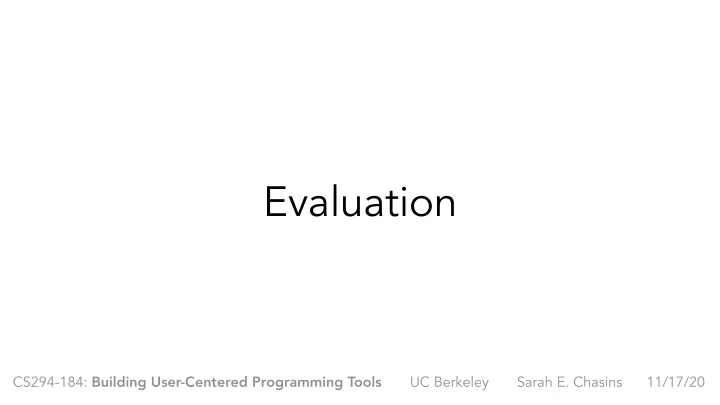

Evaluation CS294-184: Building User-Centered Programming Tools UC Berkeley Sarah E. Chasins 11/17/20
Plan for today A structured conversation about the relationship between today’s reading and our role as PL+HCI researchers
This paper played a big role in the HCI community in broadening the classes of evaluations considered acceptable, including no-evaluation papers. What’s this to do with us? usability studies? • A lot of parallels to evaluating PLs. (In your head, replace “UI system” or “UI toolkit” with “PL” and see how many observations still hold.) • Framework for how to think about meaningfully evaluating complex design contributions Thank Amy Ko for these insights, and check out her work for more of the same!
Value added by UI systems architecture (…and PLs!) • Reduce development viscosity • Least resistance to good solutions • Lower skill barriers • Power in common infrastructure • Enabling scale
Evaluation Errors • The usability trap • The fatal flaw fallacy • Legacy code
Usability Trap Common measures • Time to complete standard task • Time to reach proficiency • Number of errors Sound familiar?
Another take on the usability trap, well worth a read • Usability eval as weak science • Do we end up picking problems and solutions that are amenable to these evals rather than picking research question, then choosing eval that fits? • We often do it as existence proof rather than testing risky hypothesis. • Using usability eval too early • Quashing cool ideas by testing for usability before they’re usable, even if they have promise • Consider too few ideas; many parallel ideas standard in other design and engineering fields • Innovation, Cultural Adoption • Usable vs. useful • Discovery: find facts about the world • Innovation, invention: create new and useful things • Many very useful inventions (e.g., cars) started out pretty unusable • Even our best inventors often don’t anticipate how culture will use the inventions
Usability Trap Let’s chat! Common assumptions • Walk up and use, minimal training • Using doesn’t require expertise, or if it requires specific expertise many people already have that expertise • Standardized task assumption • If we’re going to compare across two systems… • Scale of the problem • Task usually needs to be completable in 1-2 hours
Let’s chat! The fatal flaw fallacy Say every time someone proposes a new PL or new abstraction, we try to find a program that can’t be expressed with it. Is that a good way to evaluate?
Let’s chat! Legacy code Is it bad to propose new languages when people are already so experienced with existing ones? When they have so many libraries available? So much code already written?
What else can we use to evaluate if PLs, abstractions, programming systems, programming tools contribute something valuable? If we won’t eval usability, covering everything, and if we allow we don’t have to be backwards compatible with all legacy code?
For the next few slides, we’re going to take the reading’s contribution types one at a time. In your breakout groups, please brainstorm ways to demonstrate these claims for PL/ Programming Systems contributions.
I recommend having the reading open in front of you if possible, for inspiration. But I also recommend brainstorming on your own before you refer back to it! If you struggle to come up with ideas, try making it more concrete. How would you assess this contribution for work in the domain of your final project? The final projects you critiqued last week?
Importance
Problem not previously solved
Generality
Reduce solution viscosity
Empowering new design participants
Power in combination
Can it scale up?
What do we get to claim? • The fact that there are other ways to demonstrate value of PL/Programming Systems contribution doesn’t mean we get to make unsupported usability claims • Demonstrating one of these contributions doesn’t mean the tool is usable or that we get to make usability claims without usability eval • Don’t get to make unsupported claims about these alternative contributions either! • But we do get to think creatively about how we evaluate them
So why’d we do this? • Usability isn’t the only thing we can evaluate. • Sometimes it’s not practical to evaluate it for PLs. • …but we have alternatives available! We don’t have to just give up on human factors evaluations. • The range of options means we have to be thoughtful about our goals, what we want to claim, what we evaluate
Takeaways • Highly encourage you before designing an evaluation to decide which of these dimensions (or others) about which you want to make claims • Sit down with the list, write out the specific claim • Then design the eval
Recommend
More recommend